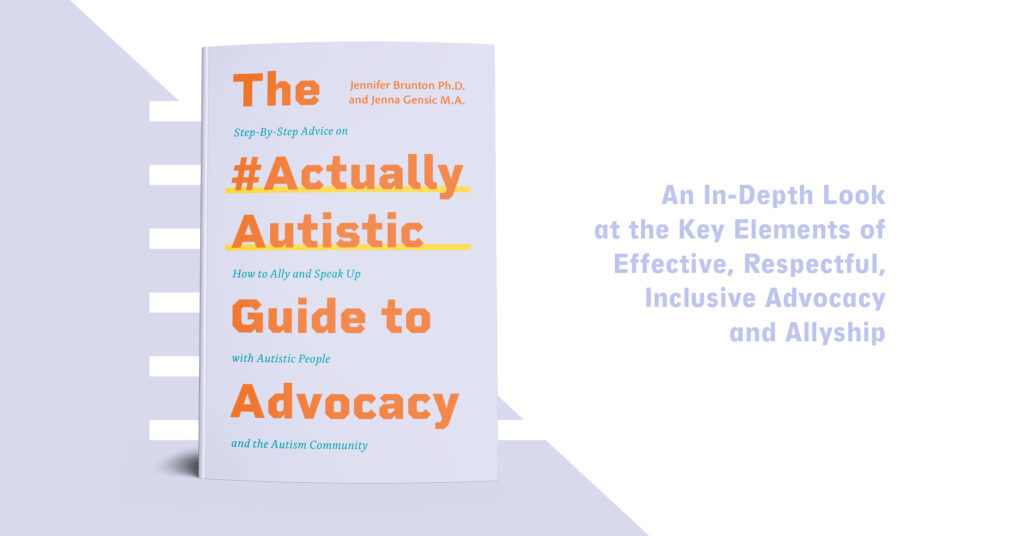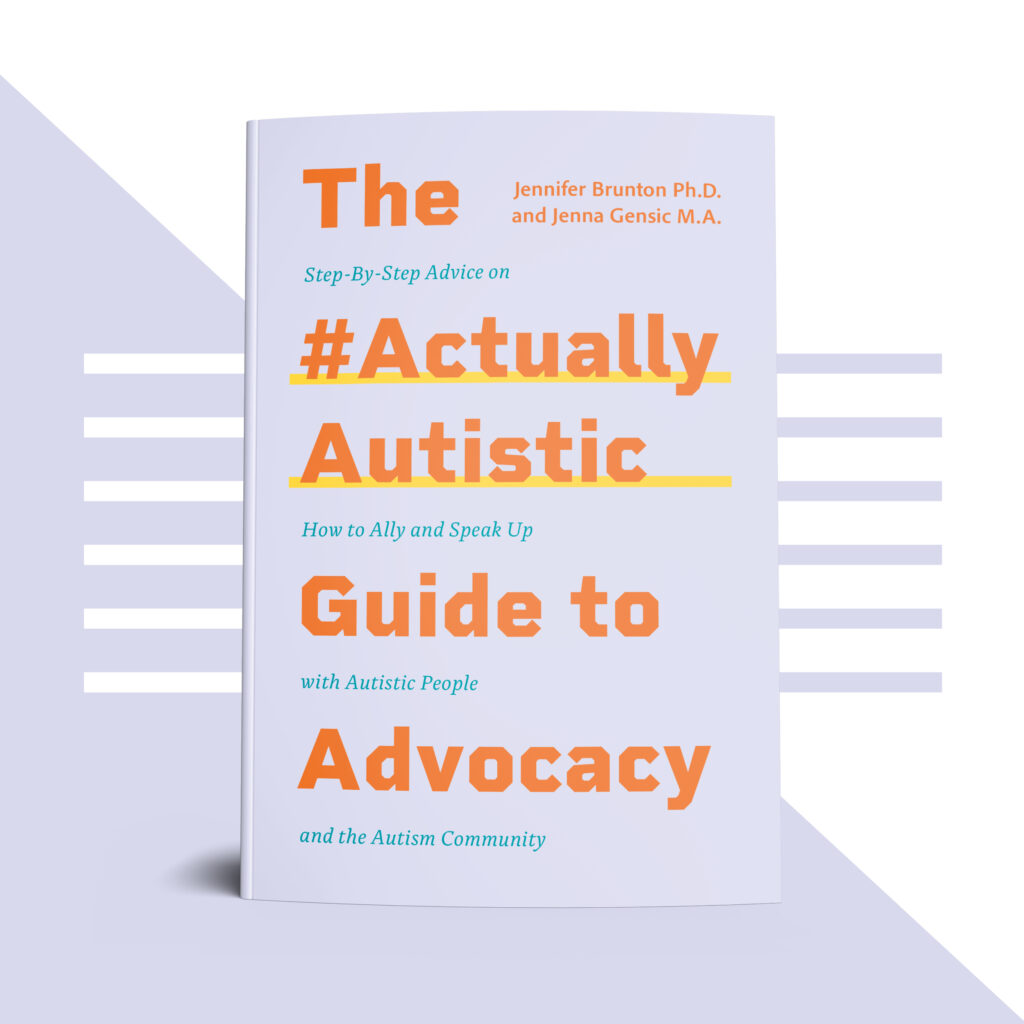The #ActuallyAutistic Guide to Advocacy releases February 21, 2022. Click here to find out more.

Can you briefly outline your histories? How has this background influenced what you write about?
Jenny:
I grew up an undiagnosed Autistic female in a complicated family. I’ve always been decent at masking, with people generally just seeing me as “a bit different”. I paid a price for it on many levels, from physical to emotional and more. When I first learned about autism, I finally began to understand myself. My son’s diagnosis at seven years old (nope–I had no idea) and his experiences in school as well as with peers and others, turned me into an advocate and activist. Over time, I’ve come to see my neurology as a great strength and to turn shame about “not getting the world” into pride about having a fresh perspective on most everything.
Jenna:
I first heard about autism when my younger brother received a diagnosis of Asperger’s Syndrome. But when my first son also received an autism diagnosis, I became even more motivated to learn in order to provide him with the best opportunities to learn and grow.
I spent a few years overwhelmed with the conflicting advice from non-Autistic “experts” before reaching out directly to the Autistic community for guidance. I started reading material authored by Autistic people. And I interviewed Autistic adults, learning what parents, friends, or teachers had done that helped or hurt them. Often what Autistic people I interviewed identified as important differed from what medical experts I previously consulted touted. I quickly learned that the Autistic community would provide the best advice on raising my son and advocating for a more inclusive society. I am pleased to have made many friends in this process.
What do you hope parents (especially neurotypical parents) learn from The #ActuallyAutistic Guide to Advocacy?
Jenny:
As an Autistic parent, it’s a priceless gift to see voices of people like my son and me amplified. Like almost everyone parenting young children, I initially thought the experts must know more than me and (I hate to admit this) did consider interventions and attitudes that were not truly supportive of my son as a fully equal and valuable human being just as he was. On the surface, this was because I wanted to spare him the pain I’d endured, but it was also—to be brutally honest—rooted in long-internalized shame.
Of course I hope this will help open neurotypical parents’ minds and hearts to the inherent worth of their children and inspire them towards autism-positive advocacy that promotes inclusion and respect. But even more, I see you, Autistic parents. This book is full of tools and validation for parenting from a place of self-respect (whatever our age, whatever our journey), respect for our children (whatever their age, whatever their journey), and awareness.
Jenna:
This book will help well-intentioned parents better align their advocacy behaviors with the desires of the Autistic community. Advocating for a marginalized community that you do not identify with is tricky. I’m neurotypical, and there is a very particular role I have in autism advocacy. Neurotypicals must listen, learn, and serve. We can’t have our own advocacy agendas or assume we know the best way to advocate. I hope this book will inspire neurotypical parents to move beyond good intentions with easy-to-implement, immediately practical autism-positive behaviors.
What do you hope Autistic people take away from The #ActuallyAutistic Guide to Advocacy?

Jenny:
Oh, everything I have gotten out of being a part of this project! Just for starters: hope, strength, humor, feelings of worth and visibility, facts about autism, deep empowerment, knowledge about human rights, confidence, acceptance, flashes of joy and recognition, a broadened perspective, community, powerful tools, and language for progress on a variety of levels.
Jenna:
I hope Autistic people feel like their voices are heard. I hope they feel empowered to become more confident self-advocates and believe in a more accepting future that embraces neurodiversity.
In the past couple years, so much research has been done on neurodiversity and how people learn differently. What small steps can teachers and educators take to help students become self-advocates?
Jenny:
Jenna, a former teacher, sums up some wonderful points below. Educators felt overwhelmed before the pandemic. So it feels a little unrealistic to ask them to take on more. I would simply add two approaches to what Jenna says above, which I think bring it all together:
- Treat each student as a unique human being with their own inherent worth, neurology, ways of learning, and more.
- Know when you don’t know, and ask questions. This stance would naturally preclude automatically grouping students by “type,” using commonly accepted language that can be hurtful, etc.
When I taught at the college level–whether at the local community college or in an Ivy League university–I based my teaching on these two pillars and always managed to create a safe space for very diverse students.
Jenna:
Positive classroom climates are foundational to creating a comfortable, confident space for self-advocacy. This often means the classroom is well managed, with clear expectations/rules/routines, and there is mutual respect between students and teachers. Teachers will ultimately benefit from learning about neurodiversity, ableism, and how to use autism-positive or autism-neutral language.
Beyond that, have an open mind to learning about individual needs. Recognize that effective education looks different for different people (and what is equal is not always equitable). Then having the creativity and flexibility to nourish learning in a variety of ways is essential to supporting self-advocacy in the classroom.
What was your initial inspiration for The #ActuallyAutistic Guide to Advocacy?
Jenny:
I had been thinking for some time about turning my blog into a book, but wasn’t sure doing so was the right direction for my material. I originally planned to be just a contributor to this book but then began pro bono editing partway through. We quickly figured out that we worked fabulously together and that having a neurodivergent co-author was exactly what the book needed. From that point on, writing the book was a collaborative process. I’m super grateful to Jenna for doing those interviews!
We are already deep into the second book, The #ActuallyAutistic Guide to Teen and Young Adult Advocacy and Activism: Step-by-Step Advice for Autistic Youth and Those Who Care About Them, which uses a survey for the same purpose. Furthermore, we are actively collecting responses from Autistic teens and young adults. We offer both a short form survey and a longer survey (for those who enjoy writing!).
Jenna:
During my regular interviews with Autistic adults for the Learn From Autistics website that I created, I remained continually surprised by mistakes they reported that neurotypical advocates were making. These were things well-intentioned parents, caregivers, therapists, and teachers thought were helpful, but weren’t. In some cases, these advocacy behaviors were actually harmful. I became immediately curious about all areas where autism advocacy might ‘miss the mark’ and started reaching out to Autistic people interested in sharing their advice. I hope a book like this will strengthen the initiatives requested by the Autistic community and ultimately lead to greater understanding, acceptance, and inclusion.
Are there any other resources you would recommend?
Jenny and Jenna: The Autistic Self Advocacy Network (ASAN), The Autistic Women & Nonbinary Network (AWN), Communication First, Neuroclastic; Loud Hands: Autistic People, Speaking, All the Weight of Our Dreams: On Living Racialized Autism, many of the amazing books offered by JKP.